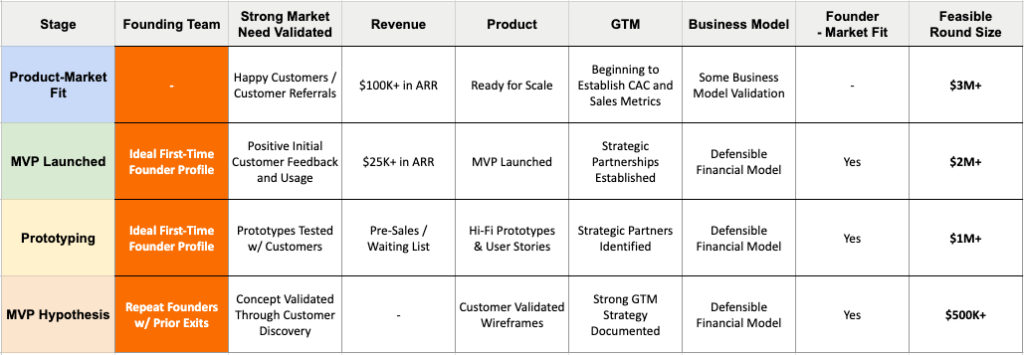Here’s what you should know:
- Fundraising Feasibility Matrix: Understanding when to raise funds is crucial. The matrix developed by Mark II illustrates that the earlier a startup wants to raise funds, the more experience the founders need.
- Founder Profile Assessment: The suitability of a founder to build a company is assessed based on their startup experience, market-fit, capabilities, and willingness to work without a salary. A founder’s background and experience directly impact the success of the startup and its ability to secure funding.
- Founder Experience and Fundraising Stages: Founders with more experience can raise capital at earlier stages. Each stage of a startup (MVP Hypothesis, MVP Launched, and Product-Market Fit) corresponds with the founders’ experience and potential fundraising amounts.
- Timing for Fundraising: Ideally, a startup should raise its first institutional round of capital once it has achieved Product-Market Fit (PMF). This can help avoid significant dilution and secure a better valuation. However, most founders raise capital before reaching this stage due to financial needs or high product development costs. It’s important to raise the least amount of money possible before reaching PMF.
Over the past year, we have spoken with hundreds of aspiring startup founders and dozens of leading early-stage VCs. A crucial aspect of the value proposition of a venture studio, such as Mark II, is understanding when these two parties are prepared for one another. As an experienced co-founders of startups, we help our companies reach the necessary milestones to optimally position them for institutional capital without incurring unnecessary dilution.
We recently created the below “Fundraising Feasibility Matrix” to assist founders in determining what they need to achieve, based on their background, before attempting to raise institutional capital. Knowing when to raise funds is particularly important now that the recent era of easy money has ended and investors are once again carefully considering each investment decision.

This matrix illustrates the relationship between the startup’s stage and the founders’ experience. The earlier you want to raise funds, the more experience the founders need. This is a simple concept, but one that was distorted over the past few years during the easy-money days of VC.
When raising capital for a business that has not yet validated its product and business model, you are asking investors to trust that you will figure everything out. In this context, trust is based on believability. If you have successfully built a business before, it is easier for investors to trust (believe) that you have the skills and temperament required to do it again. If you have not successfully done it before, investors will want to see more proof points in the form of business performance milestones before trusting your ability to execute on the opportunity.
Understanding Your Founder Profile
Okay, so you’ve got a great idea to build a killer product that will create a ton of value for your customers. Awesome! But why are you the right person to build this company? Every sophisticated investor will ask themselves (and you) this question.
To answer this question, you must be brutally honest about your background and experience. Sometimes, this might even mean admitting that you are NOT the right person to build the company. In those cases, you will want to recruit other founders to help you build the business who do have the necessary skills and experience to improve your odds of success (and ultimately your own financial rewards).
At Mark II, we evaluate founder profiles based on a few criteria. The primary areas we consider are:
- Prior Startup Experience: Ranging from a repeat, successful founder (most ideal) to no prior startup experience (least ideal).
- Founder-Market Fit: Concerning the founder’s previous experience in the industry or domain where the startup will operate. Deep industry knowledge and expertise are ideal.
- Capabilities: Do the founders possess the variety of skills necessary to achieve Product-Market Fit (PMF) with minimal support from others?
- Willingness: What separates a founder from an employee is the willingness to work on getting something off the ground without earning a salary.

The Relationship Between Founder Experience and Fundraising Stages
The Fundraising Feasibility Matrix demonstrates that founders with more experience can raise capital at earlier stages. If you have successfully built a startup before, you can typically raise some capital with little more than a good idea. If you haven’t done it before, then you’ll need to demonstrate your capabilities and the viability of your idea before attempting to raise funds.
Here’s how each stage correlates with founder experience and potential fundraising amounts:
MVP Hypothesis Stage
At this early stage, a startup might be little more than a well-validated concept and a strong go-to-market strategy
- Raising at this stage is only recommended for repeat founders with prior success
- Fundraising potential: $500K+
- Even though a successful founder can likely raise more at this early stage, we prefer the discipline that comes from resource constraints
- Only recommended for first-time founders that fit the “ideal profile” requirements
- Fundraising potential: $1M+
MVP Launched Stage
At this stage, startups have launched a basic product and received positive initial customer feedback. Typically, the startup generates some amount of revenue.
- First-time founders with strong startup experience can typically raise at this stage
- Fundraising potential: $2M+
Product-Market Fit Stage
At this stage, you have proven that the market wants what you’re selling and that your product is delivering it successfully. You’re typically generating real revenue and have happy customers (other than your friends) who are referring you to other customers. You can barely keep up with demand and desperately need more resources.
- Any founder who can get here, regardless of prior startup experience, is likely investible
- Fundraising potential: $3M+
Choosing the Right Time to Raise Funds
When should you raise your first institutional round of capital? Our recommendation is always the same: once you reach Product-Market Fit. We realize this isn’t always possible, but it is always ideal.
If you can reach PMF without raising capital, you’ll avoid significant dilution and receive a better valuation – even if you lack the ideal founder profile. And if you do have a strong founder profile, you’ll command a premium valuation! Once you reach this stage, you’ve demonstrated your capabilities as a founder as well as the viability of your business, so investors don’t have to take a significant leap of faith to bet on you. This will result in the ability to raise more capital at a higher valuation and on more founder-friendly terms.
However, most founders will raise some capital before reaching this stage. Sometimes founders can’t afford to work without drawing a salary, or the product being built is unusually expensive (typically due to third-party development costs or dependencies). Whatever the case, we recommend raising the least amount of money possible before reaching the Product-Market Fit stage. Just like living off credit card debt is not advisable, pre-PMF capital is incredibly expensive and should be kept to a minimum.
Understanding the correlation between founder experience and fundraising feasibility can help you determine the best time in your startup’s lifecycle to raise institutional capital. By assessing your own experience and the current stage of your startup, you can evaluate your readiness for capital from an investor’s perspective. Most importantly, the more you can achieve before raising capital, the better your personal economics will be in the long run.





